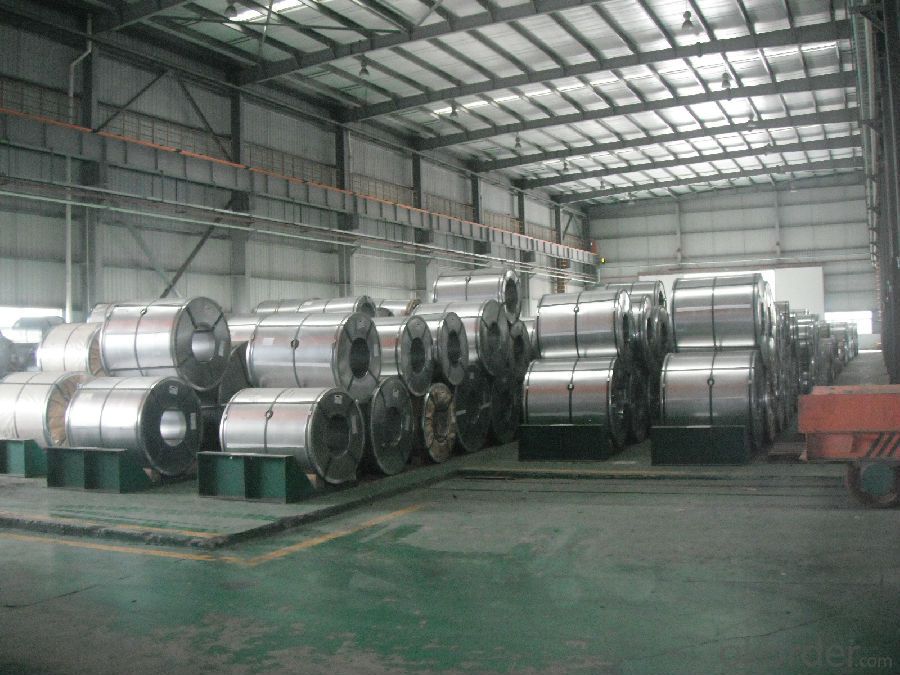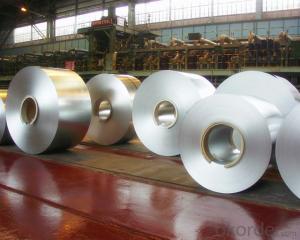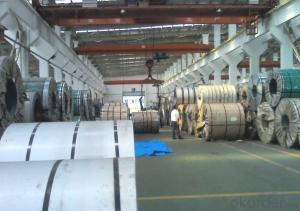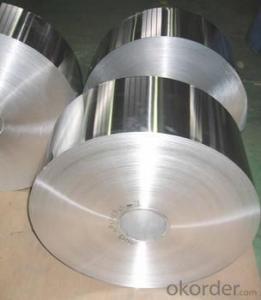GI/CGI/SGCC Galvanized Steel Sheet In Coil
- Loading Port:
- Qingdao
- Payment Terms:
- TT OR LC
- Min Order Qty:
- 25 m.t.
- Supply Capability:
- 10000 m.t./month
OKorder Service Pledge
OKorder Financial Service
You Might Also Like
GI/CGI/SGCC Galvanized Steel Sheet In Coil
1.Structure of GI/CGI/SGCC Galvanized Steel Sheet In Coil
GI/CGI/SGCC Galvanized Steel Sheet In Coil is widely used in the construction industry, as raw material for the production of corrugated panels, fencing products, drywall panel profiles, ventilation systems etc. Recommended for both outside and inside usage, galvanized steel has a high resistance to corrosion in different environments, due to a protective layer of zinc of 100 – 180 grams per square metre.
Hot-dip galvanized steel coils are produced by immersing steel in a zinc bath. An appropriate galvanizing process requires a pretreatment process during which the steel passes through different baths which prepare the surface for zinc coating. In this stage, chemicals are used to clean the surface of the steel. After the chemical treatment, the steel coils pass through a bath of melted zinc at temperatures around 460 ° C. The resulting uniform coating is finished through a process of skin-passing to provide smooth and shiny appearance of the finished product. To store for a longer period, the hot-dip galvanized coils can be delivered with a final oil coating, according to the customer’s demand.
2.Main Features of GI/CGI/SGCC Galvanized Steel Sheet In Coil.
1) Rust-proof
2) Water-proof
3)Durable using
3. GI/CGI/SGCC Galvanized Steel Sheet In Coil Images


4. GI/CGI/SGCC Galvanized Steel Sheet In Coil Specification
1)Based raw material: Hot rolled steel coils or Cold rolled steel coils
2) Thickness
3) Width
4)Coating mass
5) Spangle
6)Surface treatment
7)Coil inner diameter
8)Painting kind
9)Painting color
10)Painting thickness
5.FAQ of GI/CGI/SGCC Galvanized Steel Sheet In Coil
We have organized several common questions for our clients,may help you sincerely:
①How about your company?
A world class manufacturer & supplier of castings forging in carbon steel and alloy steel,is one of the large-scale professional investment casting production bases in China,consisting of both casting foundry forging and machining factory. Annually more than 8000 tons Precision casting and forging parts are exported to markets in Europe,America and Japan. OEM casting and forging service available according to customer’s requirements.
②How to guarantee the quality of the products?
We have established the international advanced quality management system,every link from raw material to final product we have strict quality test;We resolutely put an end to unqualified products flowing into the market. At the same time, we will provide necessary follow-up service assurance.
③Could I have your Processing technique introduction?
Processing technique:
| adopt wide hot galvanized strip produced by famous company as Bao Steel which has even thickness |
| we introduce a new complete set of cutting technology |
| keep steady precision |
| reduce waste of material farthest |
| adopt physical technique in order to make the galvanized level thicker |
| enhance the rustproof capability |
| adopt non-chrome passivation technique |
| protect the environment against pollution |
| adopt level pressure technique and inert gases protect technique |
| make the galvanized level brighter |
| delay oxidation phenomenon in natural environment |
- Q:How do steel strips compare to steel sheets?
- Various industries utilize steel strips and steel sheets, which are both common forms of steel. However, they vary in terms of thickness, width, and application. Steel strips, being narrow and elongated, typically boast a thickness ranging from 0.2mm to 6mm and a width below 600mm. These strips find frequent use in precise applications, such as automotive components, electrical appliances, and construction materials. Their slender nature allows easy manipulation, enabling bending, forming, and cutting into specific shapes. Additionally, their narrow size makes them an ideal choice for weight reduction in crucial applications. Conversely, steel sheets are larger and flat pieces of steel, usually featuring a thickness between 0.6mm and 25mm and a width exceeding 600mm. Construction, shipbuilding, industrial machinery, and general fabrication widely employ steel sheets. Their structural strength and stability render them suitable for load-bearing purposes, including building frameworks, bridges, and heavy machinery. Although both steel strips and steel sheets share the same material, their differing dimensions and applications provide them with distinct utilities. Steel strips exhibit versatility, allowing intricate designs and precise manufacturing. On the other hand, steel sheets offer strength and stability for heavy-duty applications. Ultimately, the choice between steel strips and steel sheets depends on the specific project requirements and desired characteristics of the final product.
- Q:Are steel strips commonly used in the manufacturing of storage systems?
- Yes, steel strips are commonly used in the manufacturing of storage systems due to their strength, durability, and ability to support heavy loads.
- Q:How are steel strips used in the production of metal furniture?
- Steel strips are used in the production of metal furniture to provide strength, stability, and durability. These strips are commonly used as framing materials or reinforcement components in various parts of the furniture, such as the legs, supports, and frames. They help to ensure that the furniture can withstand heavy loads, resist bending or warping, and maintain its structural integrity over time. Steel strips also allow for precise shaping and bending, enabling manufacturers to create intricate designs and details in the furniture.
- Q:What are the specifications for steel strips used in the production of watches?
- The specifications for steel strips used in the production of watches can vary depending on the specific requirements of the watch manufacturer. However, there are some general specifications that are commonly used in the industry. Firstly, the steel strips used in watch production are typically made from high-quality stainless steel. Stainless steel is chosen for its durability, corrosion resistance, and aesthetic appeal. The thickness of the steel strip can vary, but it is usually in the range of 0.10 to 0.30 millimeters. This thickness allows for the creation of thin and lightweight watch components while still maintaining structural integrity. The width of the steel strip is also an important specification and can vary depending on the design and size of the watch. Common widths for watch steel strips range from 4 to 20 millimeters. In terms of surface finish, watch steel strips are often polished to achieve a smooth and shiny appearance. The level of polish can vary, with some watches featuring a high mirror-like finish, while others may have a brushed or matte finish. Another important specification is the hardness of the steel strip. Watch components require a certain level of hardness to ensure they can withstand daily wear and tear. The hardness is usually measured on the Rockwell scale, with a typical range of 45 to 60 HRC (Rockwell C scale). Furthermore, the steel strips used in watch production may undergo additional treatments such as heat treatment, coating, or plating to enhance their performance, durability, or visual appeal. It is important to note that these specifications can vary depending on the specific watch brand and model, as different manufacturers may have their own unique requirements and preferences. Therefore, it is essential for watchmakers to ensure they source steel strips that meet their specific specifications and quality standards.
- Q:How are steel strips processed for slitting into narrower widths?
- To create narrower steel strips, mechanical operations are utilized to process steel strips. The initial step involves uncoiling the steel strip from a large coil and feeding it into a slitter machine. This machine contains multiple circular blades that are spaced apart based on the desired width of the final strips. While the steel strip passes through the slitter machine, the circular blades rotate and cut the strip into narrower widths. The width of each strip is determined by the distance between the circular blades. To ensure the steel strip remains taut throughout the process and avoid any buckling or creasing, the slitter machine is equipped with a tensioning system. Following the slitting process, the steel strip undergoes additional processes to refine and finish the strips. These processes may include edge trimming, where any uneven or rough edges are removed to achieve smooth and precise edges. Additionally, the strips may be leveled to eliminate any residual stresses and maintain flatness. Once all the necessary processing steps are completed, the narrower steel strips are recoiled and packaged for shipment or further processing. The slitting process allows for the production of multiple narrower strips from a single large coil, enhancing the versatility and usability of the steel in various applications. In summary, the processing of steel strips for slitting into narrower widths involves precise cutting, edge trimming, leveling, and recoiling to produce strips that meet specific width requirements and quality standards.
- Q:Are steel strips commonly used in the manufacturing of appliances?
- Yes, steel strips are commonly used in the manufacturing of appliances. Steel strips provide strength, durability, and resistance to corrosion, making them ideal for various components and structures within appliances.
- Q:How are steel strips processed for surface bending?
- Steel strips are processed for surface bending through a series of steps that involve heating the material to a specific temperature, followed by applying pressure or force to bend it into the desired shape. This can be done using various methods such as hot rolling, cold rolling, or even using specialized machinery like a press brake. The process may also involve additional treatments like annealing or quenching to enhance the steel's flexibility and strength.
- Q:How do steel strips respond to different machining processes?
- Different machining processes elicit varying responses from steel strips, which depend on factors such as the steel type, desired outcome, and specific machining technique employed. In the realm of cutting processes like shearing or sawing, steel strips exhibit favorable responses owing to their high strength and hardness. Nevertheless, careful consideration of the cutting tool and cutting parameters is imperative to achieve a clean cut and prevent excessive tool wear. Drilling or milling operations may require heightened attention when working with steel strips due to their tough nature and proclivity to work harden. The utilization of appropriate cutting tools with suitable geometries and coatings is essential to effectively remove material and prevent excessive heat accumulation. Turning or lathing operations pose challenges, especially when dealing with harder grades of steel strips. The selection of cutting tools must be meticulous to withstand the substantial forces involved and ensure optimal chip control and surface finish. Grinding serves as another prevalent machining process employed on steel strips, particularly for attaining precise dimensions and surface finish. This process effectively eliminates material and enhances the strip's dimensional accuracy. However, specific grinding wheels and coolant systems are necessary to regulate heat generation and maintain dimensional stability. All in all, steel strips possess versatility and can be machined through various processes. However, it is crucial to account for the steel's specific characteristics, desired outcome, and the capabilities of the machining equipment to guarantee successful and efficient machining operations.
- Q:How do steel strips contribute to structural integrity?
- Steel strips contribute to structural integrity by providing strength and stability to the structure. They are often used as reinforcements in beams, columns, and other load-bearing elements, effectively distributing and transferring the load across the entire structure. Additionally, steel strips enhance the resistance to bending, torsion, and shear forces, ensuring the overall stability and durability of the structure.
- Q:How are steel strips used in the production of surgical instruments?
- Due to their unique properties, steel strips are essential for the manufacturing of surgical instruments. These strips, typically made from high-quality stainless steel, offer exceptional strength, durability, and resistance to corrosion. To begin the manufacturing process, the steel strips are cut into precise dimensions, ensuring uniformity and accuracy in the shape and size of the surgical instrument. Specialized machinery, such as press brakes or bending machines, is then used to shape the strips into various components like handles, blades, clamps, or forceps. To achieve the desired shape and functionality of the surgical instrument, the steel strips undergo additional processing techniques such as forging, stamping, or machining. Forging involves the application of heat and pressure to mold the steel strip into complex shapes, enhancing its strength and durability. Stamping utilizes a die to cut or shape the steel strip, resulting in intricate designs or patterns on the instrument's surface. Machining, on the other hand, utilizes computer-controlled tools to remove excess material and create precise cuts, holes, or threads. Furthermore, heat treatment can be applied to the steel strips to improve the mechanical properties of the instrument, such as hardness or flexibility. This involves subjecting the steel to controlled heating and cooling cycles, resulting in a desired microstructure that enhances the instrument's performance and lifespan. Once the components of the surgical instruments are formed, they undergo meticulous assembly, polishing, and inspection to ensure they meet stringent quality standards. The corrosion-resistant properties of the steel strips are particularly crucial in surgical instruments, as they are exposed to various sterilization methods like autoclaving or chemical disinfection. In summary, steel strips are crucial in the production of surgical instruments, providing strength, durability, and corrosion resistance. Through shaping, processing, and assembly, these strips ensure precision and reliability in surgical procedures.
1. Manufacturer Overview |
|
|---|---|
| Location | |
| Year Established | |
| Annual Output Value | |
| Main Markets | |
| Company Certifications | |
2. Manufacturer Certificates |
|
|---|---|
| a) Certification Name | |
| Range | |
| Reference | |
| Validity Period | |
3. Manufacturer Capability |
|
|---|---|
| a)Trade Capacity | |
| Nearest Port | |
| Export Percentage | |
| No.of Employees in Trade Department | |
| Language Spoken: | |
| b)Factory Information | |
| Factory Size: | |
| No. of Production Lines | |
| Contract Manufacturing | |
| Product Price Range | |
Send your message to us
GI/CGI/SGCC Galvanized Steel Sheet In Coil
- Loading Port:
- Qingdao
- Payment Terms:
- TT OR LC
- Min Order Qty:
- 25 m.t.
- Supply Capability:
- 10000 m.t./month
OKorder Service Pledge
OKorder Financial Service
Similar products
New products
Hot products
Related keywords



























